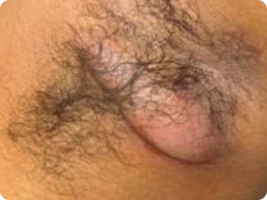
Abscess
Abscess
Image of abscess of HS patient provided by Dermatology Online Journal, copyright Noah Scheinfeld, MD.

HS can be challenging to diagnose as the clinical characteristics may be difficult to identify or mistaken for other conditions. But the consequences of a delayed HS diagnosis can be damaging and may even be permanent. Recognizing the characteristic lesions of HS and how they present across different skin tones can help get patients the care they need to help inhibit further disease progression.1-4
Less common areas2
Around the ears, back, face, scalp, chest, and legs
Early HS lesions may resemble other dermatological conditions. Knowing the common presentations, common differential diagnoses, and stage of disease can help you identify HS more quickly and make referrals to HS-treating dermatology providers sooner.2
CHARACTERISTIC HS LESIONS9-15
DIFFERENTIAL DIAGNOSIS2,9,10,16,17
STAGING HS3,18
Hidradenitis suppurativa disproportionally affects patients of color and is associated with increased disease severity. Knowing the clinical presentations of HS on darker skin tones may help you accurately identify HS.4,19
Presentations of HS unique to patients of color
Hear from your peers about identifying and diagnosing HS
Healthcare providers with experience identifying and diagnosing HS offer their wisdom for clinical evaluations.
The healthcare providers featured in these videos were compensated for their time. These videos represent their opinions and do not represent the opinions of Novartis.